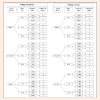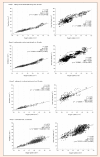A comparison between ventilation and heart rate as indicator of oxygen uptake during different intensities of exercise
- PMID: 24149394
- PMCID: PMC3737974
A comparison between ventilation and heart rate as indicator of oxygen uptake during different intensities of exercise
Abstract
The aim of this study is to compare the relation between ventilation (VE) and oxygen uptake (VO2) [VO2=ƒ(VE)] and between heart rate (HR) and VO2 [VO2=ƒ(HR)]. Each one of the subjects performed three types of activities of different intensities (walking without load, walking with load and intermittent work). VO2, VE, and HR were measured continuously by using indirect calorimetry and an electrocardiogram. Linear regressions and coefficients of determination (r(2)) were calculated to compare the relation VO2 =ƒ(VE) and VO2 =ƒ(HR) for two different regroupings: by session duration (r(2) session) and by subject (r(2) subject). Results showed that r(2) session of the relation VO2 =ƒ(VE) were significantly higher than those of the relation VO2 =ƒ(HR) for steady state activities (walking with or without load during 3 or 6 min, p < 0.01) and for activities without oxygen consumption steady state (walking with or without load during 1 min, p < 0.01 and intermittent work, p < 0.05). VE is more strongly correlated with VO2 than with HR. This is a very promising approach to develop a new method to estimate energy expenditure. Key pointsVentilation is more strongly correlated with oxygen uptake than heart rate during physical activities of different intensities.This study shows the interest to looking for ventilation to estimate energy expenditure.This study is a promising approach to develop a new method to estimate energy expenditureAn interesting perspective could be to develop a light and portable device to measure ventilation based on the coupling of four magnetometers.
Keywords: Physical activities; light to moderate intensities; non-steady state activities.; steady state activities.
Figures



Similar articles
-
Estimation of Metabolic Energy Expenditure during Short Walking Bouts.Int J Sports Med. 2021 Nov;42(12):1098-1104. doi: 10.1055/a-1373-5770. Epub 2021 Apr 16. Int J Sports Med. 2021. PMID: 33862639
-
Ventilation and heart rate response during exercise in normals: relevance for rate variable pacing.Pacing Clin Electrophysiol. 1993 Aug;16(8):1693-700. doi: 10.1111/j.1540-8159.1993.tb01040.x. Pacing Clin Electrophysiol. 1993. PMID: 7690938
-
Reproducibility of cardiopulmonary exercise parameters in patients with valvular heart disease.Chest. 1996 Sep;110(3):685-92. doi: 10.1378/chest.110.3.685. Chest. 1996. PMID: 8797412
-
Determination of lactate threshold by respiratory gas exchange measures and blood lactate levels during incremental load work.J Manipulative Physiol Ther. 1993 Jun;16(5):312-8. J Manipulative Physiol Ther. 1993. PMID: 8345314
-
Load Carrying Walking Test for the Special Operation Forces of the Army of the Czech Republic.Mil Med. 2024 Feb 27;189(3-4):e566-e572. doi: 10.1093/milmed/usad387. Mil Med. 2024. PMID: 37776528 Free PMC article.
Cited by
-
Tibetans exhibit lower hemoglobin concentration and decreased heart response to hypoxia during poikilocapnia at intermediate altitude relative to Han Chinese.Front Physiol. 2024 May 9;15:1334874. doi: 10.3389/fphys.2024.1334874. eCollection 2024. Front Physiol. 2024. PMID: 38784113 Free PMC article.
-
Comparison of physiological and perceptual responses between continuous and intermittent cycling.J Hum Kinet. 2011 Sep;29A:59-68. doi: 10.2478/v10078-011-0060-7. Epub 2011 Oct 4. J Hum Kinet. 2011. PMID: 23487483 Free PMC article.
-
The facemask produces higher peak minute ventilation and respiratory rate measurements compared to the mouthpiece.J Sports Sci Med. 2012 Sep 1;11(3):564-6. eCollection 2012. J Sports Sci Med. 2012. PMID: 24137074 Free PMC article. No abstract available.
-
Estimation of Respiratory Frequency in Women and Men by Kubios HRV Software Using the Polar H10 or Movesense Medical ECG Sensor during an Exercise Ramp.Sensors (Basel). 2022 Sep 21;22(19):7156. doi: 10.3390/s22197156. Sensors (Basel). 2022. PMID: 36236256 Free PMC article.
-
Measured by the oxygen uptake in the field, the work of refuse collectors is particularly hard work: Are the limit values for physical endurance workload too low?Int Arch Occup Environ Health. 2016 Feb;89(2):211-20. doi: 10.1007/s00420-015-1064-8. Epub 2015 Jun 19. Int Arch Occup Environ Health. 2016. PMID: 26088744 Free PMC article.
References
-
- Achten J., Jeukendrup A.E. (2003) Heart rate monitoring: applications and limitations. Sports Medicine 33(7), 517-538 - PubMed
-
- Ainsworth B.E., Haskell W.L., Whitt M.C., Irwin M.L., Swartz A.M., Strath S.J., O'Brien W.L., Bassett D.R., Jr., Schmitz K.H., Emplaincourt P.O., Jacobs D.R., Jr., Leon A.S. (2000) Compendium of physical activities: an update of activity codes and MET intensities. Medicine and Science in Sports and Eexercise 32, S498-504 - PubMed
-
- Astrand P.O., Ryhming I. (1954) A nomogram for calculation of aerobic capacity (physical fitness) from pulse rate during sub-maximal work. Journal of Applied Physiology 7, 218-221 - PubMed
-
- Bassett D.R., Ainsworth B.E., Swartz A.M. (2000) Validity of four motion sensors in measuring moderate intensity physical activity. Medicine and Science in Sports and Exercise 32, S471-S480 - PubMed
-
- Bouchard D.R., Trudeau F. (2008) Estimation of energy expenditure in a work environment: comparison of accelerometry and oxygen consumption/heart rate regression. Ergonomics 51, 663-670 - PubMed
LinkOut - more resources
Full Text Sources
